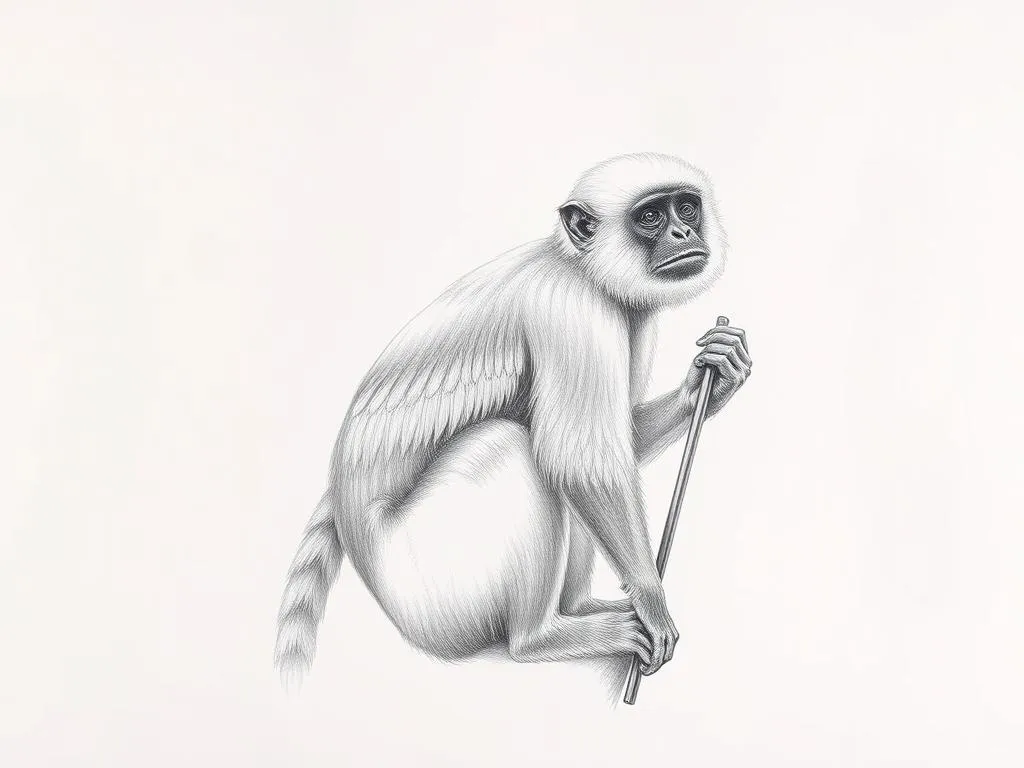The Gibbon: A Symbol of Adaptability and Connection

Disclaimer: Some images on this website are AI-generated artworks and may not accurately represent real animals.
The gibbon, a fascinating member of the primate family, embodies profound symbolism and meaning that resonate deeply with our human experience. Known for their agility and social nature, gibbons serve as a reminder of the importance of adaptability and strong relationships in our lives. This blog post explores various aspects of gibbons, from their physical characteristics and social structures to their symbolism in dreams and modern culture.
Understanding the Gibbon
Physical Characteristics
Gibbons are unique and captivating creatures with several distinctive physical traits. They are often recognized for their long arms, which enable them to swing gracefully through the trees of their Southeast Asian habitats. Below is a detailed table summarizing some key physical characteristics of gibbons.
| Feature | Description |
|---|---|
| Body Type | Slender, agile bodies designed for brachiation |
| Arm Length | Long arms, often longer than their body |
| Fur Color | Ranges from black, white, and shades of brown |
| Face | Flat faces with expressive features |
| Size | Small to medium-sized, typically weighing 15-25 lbs |
Gibbons primarily inhabit the lush forests of Southeast Asia, including regions in countries like Indonesia, Thailand, and Malaysia. These forests provide not only shelter but also abundant food sources, such as fruits and leaves, which are essential for their survival.
Social Structure
Gibbons are highly social animals that typically live in family groups. These family units often consist of a mated pair and their offspring. The bonds formed within these groups are crucial for their survival, providing support and security.
Communication plays a vital role in gibbon society. They utilize a variety of vocalizations and gestures to convey messages to one another. Their distinctive calls can be heard echoing through the forests, serving not only as a means of communication but also as a way to establish territory. This complex social structure highlights the importance of connection in gibbon life.

Symbolism & Spiritual Meaning
Adaptability and Flexibility
One of the most significant aspects of gibbon symbolism is their representation of adaptability. Gibbons are masters of their environment, showcasing an incredible ability to navigate the complexities of their forest homes. Their lifestyle reflects the importance of being flexible in the face of change.
In our own lives, this adaptability serves as a powerful reminder. Just as gibbons adapt to the shifting landscapes of their habitats, we, too, can learn to embrace change and navigate the challenges that life presents. Whether it’s a new job, a move to a different city, or the evolution of personal relationships, the gibbon’s ability to thrive in varying conditions teaches us the value of resilience.
Connection and Relationships
Another essential aspect of gibbon symbolism is their emphasis on connection and relationships. The social structures of gibbons are built on strong family bonds, showcasing the significance of companionship and support. The interactions within gibbon families demonstrate how relationships can provide strength and stability, even in the face of adversity.
In human societies, these themes resonate strongly. The gibbon encourages us to prioritize our relationships, reminding us that nurturing connections with others is fundamental to our well-being. By fostering these bonds, we can create a supportive network that enriches our lives.
Playfulness and Joy
Gibbons are well-known for their playful spirit, often seen swinging and playing among the trees. This joyful attitude embodies a sense of freedom and light-heartedness that is infectious. They teach us the importance of embracing joy and playfulness, even in the midst of seriousness.
The ability to find joy in simple activities can significantly enhance our quality of life. By channeling the gibbon’s playful essence, we can cultivate a mindset that appreciates the little moments, fostering happiness and contentment in our everyday experiences.
Gibbons in Dreams
Interpretation of Gibbon Dreams
Dreams featuring gibbons often carry rich symbolism and can provide profound insights into our waking lives. Below is a table summarizing themes commonly associated with gibbon dreams.
| Dream Theme | Interpretation |
|---|---|
| Freedom | A desire for liberation and exploration |
| Social Connections | Reflection on relationships and bonds |
| Adaptability | Need for flexibility in facing life changes |
| Joy | A call to embrace playfulness and happiness |
Freedom and exploration are significant themes when gibbons appear in our dreams. Their agile movements through the trees symbolize a longing for liberation from constraints. This can indicate a need to break free from routine or expectations, encouraging us to seek new adventures.
Moreover, dreams involving gibbons may highlight our social connections. They prompt us to evaluate our relationships, reminding us to nurture the bonds that bring us joy and support. This reflection can lead to deeper connections and a greater understanding of our social dynamics.
Modern Interpretations
Cultural Significance
In various cultures, gibbons have been represented in art, literature, and folklore. Their playful nature and social structures often inspire creative expression. Many artists and writers draw upon the symbolism of gibbons to explore themes of connection, freedom, and adaptability.
For instance, gibbons may appear in stories that emphasize the importance of family and community, serving as a reminder of our interconnectedness. Their presence in cultural narratives reinforces the idea that our relationships shape our experiences and identities.
Gibbons in Conservation
In recent years, gibbons have also become symbolic of broader conservation efforts. As endangered species, their plight highlights the importance of maintaining ecological balance. Gibbons serve as a reminder of the intricate connections within ecosystems, and their conservation is essential for preserving biodiversity.
Many organizations focus on protecting gibbon habitats, emphasizing the importance of preserving these unique creatures for future generations. By advocating for gibbon conservation, we acknowledge the interconnectedness of all living beings, reinforcing our responsibility to protect the environment.
Key Takeaways
- Adaptability: Gibbons symbolize the ability to thrive in changing environments, encouraging resilience and flexibility in our own lives.
- Connection: The strong familial bonds of gibbons remind us of the importance of nurturing relationships and social networks.
- Playfulness: Gibbons embody a spirit of joy and play, prompting us to embrace happiness and find joy in everyday experiences.
- Dream Insights: Dreams featuring gibbons can reveal themes of freedom, social connections, adaptability, and joy, offering valuable insights into our waking lives.
- Cultural Impact: Gibbons inspire creativity and reflection in art and literature, reinforcing themes of connection and adaptability.
- Conservation Significance: As a symbol of ecological balance, gibbons highlight the importance of preserving biodiversity and protecting our natural world.
Conclusion
The gibbon stands as a profound symbol of adaptability, connection, and playfulness. By understanding the attributes associated with these remarkable creatures, we can draw valuable lessons for our own lives. Just as gibbons navigate the complexities of their environment, we, too, can embrace change and cultivate meaningful relationships.
Reflecting on the gibbon’s graceful movements and social structures encourages us to seek deeper connections and foster joy in our daily experiences. As we look to nature for guidance, let us remember the importance of adaptability and the beauty of our relationships, allowing the spirit of the gibbon to inspire our journeys through life.







